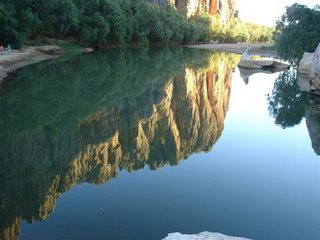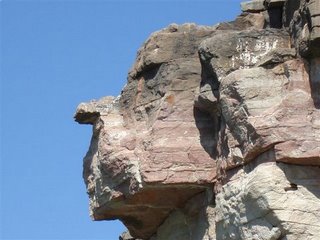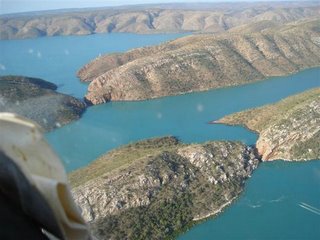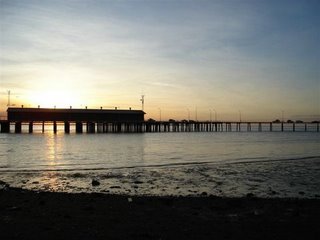Being blessed with an abundance of water Kununurra proved to be a lovely little town full of green lawns, parks, mountains and lake views. Zebra Rock Gallery was one of the first places we visited. There a wide variety of ornaments are created from a stratified siltstone (estimated to be 600 million years old) that is found nowhere else in the world. Some of the material, containing petrified algae, is said to be twice that age! A very striking material with iron rich red bands and spots contrasting with a white background and out in the backyard a large number of old timers cutting, shaping and polishing the material in a dusty old workshop. Great stuff! What is more the itinerant workforce all live in caravans parked in the backyard! George was most envious. Down on the jetty Lea found a huge shoal of catfish desperate for hand-outs! After fetching some bread for them, the feeding frenzy that resulted was an extraordinary sight.
We chanced on a particularly pertinent TV program shown on Four Corners about the people pressures that are becoming apparent on the coast of WA. It focused on the very places that we have been camping at over the past few months (14 Mile Beach, Ningaloo, Lefroy Bay, Red Bluff, Gnarloo, Shark Bay …) and the influence that grey nomads are having on the environment. As mentioned in previous weeks, we too have been amazed at the numbers of nomads living semi-permanently on the coast. George couldn’t help but express concern about all the attendant impacts related to access, waste disposal, sanitation, dune conservation, the launching of boats and other issues. While all these problems appear to be effectively managed by station owners and nomads alike, once the station leases expire in the year 2015 …. the ultimate fate of many a grey nomad’s current lifestyle, that of spending months at a time living on the coast free of regulations and overheads, probably hangs in the balance.
Faced with having no fridge until we get to Darwin (800km away) we found ourselves reappraising our travel plans! We decided to backtrack towards Wyndham and the eastern end of the Gibb River road, leaving Getaway safely stored in Kimberleyland Park for the bargain price of $2 per day.
Arriving to the desiccated surrounds of Wyndham from the well watered Kununurra was a bit of a shock to the system. As in the case of Derby’s King Sound – Wyndham is dominated by the muddy waters of the Cambridge Gulf, itself renowned for the massive 8m tides and being home to some of the largest saltwater crocodiles in the world. A 20m long crocodile met us at the entrance to the town, an impressive beast made from ferrous cement!
We chose to have our lunch up on the Five Rivers Lookout, perched high above Wyndham. There we were able to look out over the extensive tidal flats that surround the Gulf.
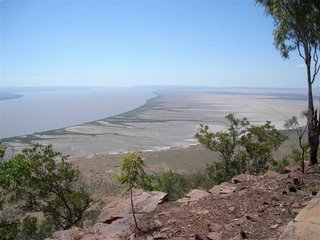
View from the Five Rivers Lookout above Wyndham, of the tidal flats adjacent to the Cambridge Gulf
In the heat haze we were able to just make out the course of the five major rivers – the Ord, King, Pentecost, Forrest and Durack - that enter the Gulf across the plains.
A reminder of the harsh conditions found in this remote town came from the graves in the Pioneer Cemetery of 12 men that died as a result of heat while constructing the Wyndham meat works in 1916/17. Having been avid readers of the book Crocodile Attack (by Hugh Edwards) we at once recalled that the meat works (now closed) used to discharge blood and offal into the Cambridge Gulf. The greatest concentration of saltwater crocodiles to be seen in Australia at the time could be found in the “red waters” of a drain at the mouth of the discharge pipe. We even visited the boat ramp where the inebriated truck driver, Paul Flanagan, claiming to the world that “the Wyndham crocodiles were all bullshit” was promptly killed by a croc in November 1980. A scary place is the muddy waters of the Cambridge Gulf and its population of silent, invisible “salties”!
As we left Wyndham we spotted the Afghan Cemetery – historically, the camel men of Australia and we couldn’t resist going to see it. These few simple graves had no names or dates and a notice informed us that the large size of a grave was due to the lead camel being buried with his master!
Without Getaway in tow we were able to do our sightseeing much faster and by early afternoon we had seen all there was to see in Wyndham. Taking the King River gravel road that by-passes a cattle station “Diggers Rest” where we’d heard we could camp. Only to find that, although set amidst boabs, it looked so desolate that we could not bear the thought of sitting out the rest of the afternoon in such a place. After asking about the condition of the roads that continue through to the Gibb River Road, we elected to take what is known as the Karunji Track.
This track, described in pamphlets as a “secluded stock route”, is a 50km 4WD track that skirts the Cockburn Range and follows the valley of the Pentecost River. Thanks to the varied terrain through which we passed the Karunji track made for a very interesting and challenging drive! The first section led us onto the flats that lie alongside the west arm of the Cambridge Gulf. Racing at 70kph over the plains with mirages shimmering in the distance and passing doleful cattle in what resembled a desert, we were reminded of Burt Munro, the Legend of Speed, on his Indian motorcycle!

Skiv on the tidal flats of Cambridge Gulf's west arm
In due course our mad dash was reduced to a crawl while traversing rocky foothills and eroded gullies. Later we faced a section lying feet deep in bull-dust - a clay surface reduced to a talcum-like powder by tyres is the most shocking stuff to negotiate. A number of diversions around the really bad spots helped a lot. At one point on the track we encountered a barbed wire fence with no less than 27 dead fruit bats hanging from the wires over a distance of 1km!
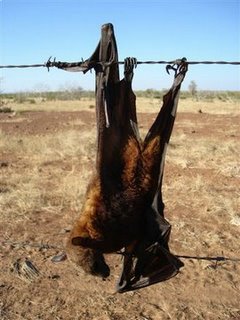
The mystery of the dead fruit bats (27) hanging on a 1 km fence
What accounted for this we don’t know! Perhaps the bats had been killed and hung there by some freaky fellow? Had the bats killed themselves by colliding with the fence? It was not an electrified fence. The mystery of the “flying fox fence” is intriguing!
Our track eventually came out at the point where the Gibb River Road crosses the Pentecost River. With nightfall fast approaching we were delighted to find a secluded spot above the river to stay in. Here we spent a very peaceful night in the company of some curious cows and, when darkness set in, fruit bats came to feed on the blossoms in the trees above us.
Our next port of call, 25km distant, was the much spoken about and advertised El Questro Wilderness Park (ELQ). We had expected ELQ to be up-market but we were “gob-smacked” (as the Aussies say) at the price of staying there! Knowing that we had just had a free night camping at the Pentecost River it was a little disconcerting to fork out $70 to camp a little further upstream! In time we realised that it wasn’t quite so prohibitive. $30 covered the permit required for all ELQ attractions (one of which was using the Karunji Track – which we didn’t realise at the time) The other $30 our night’s camping fee. We had the option of using the general site with ablutions or one of their many secluded sites established alongside the river, each out of sight and earshot of the other. Guess what we chose!
Just as one should be discerning over the choice of castles or cathedrals to visit in England much the same applies to the many gorges of the Kimberley. The ELQ property had its own list of gorges. After visiting three we became aware of how easy it is to overdose particularly after the magic of Windjana and Bungle Bungles. It is unfair to judge their qualities when seeing so many one after each other. In the heat of the day we happily retired to the shade of our campsite, with the cool sound of the river rapids and the chirruping of Rainbow Lorikeets and honey-eaters as they gorged themselves in the trees flowering overhead. At evening time our thoughts turned to young brother-in-law Bernd celebrating five decades. What time the partee start?
On leaving this portion of ELQ early the next day, we popped in to see Zebedee Springs described as a “private day spa open from 6a.m – 12 noon”. After a short walk through dense palm forest we discovered a crystal clear stream of warm water flowing from the base of a towering cliff into a series of small pools. Quite the most idyllic spot and too good to resist! Lea returned for swimming costumes while George took photos. Meanwhile, back in the car park, life was now abuzz with families making their way up to this piece of paradise. In no time at all, the place became invaded by people – excited kids and goggles. We wallowed in “our pool” for ten minutes but the people pressure soon got the better of George. Lea, most reluctantly had to leave her element!

Aquarian in her element at Zebedee Springs, El Questro
We may have blunted our pleasure in gorges. However, Emma Gorge on the Gibb River Road is one of those much publicised places that we did not want to overlook. With many loose stones on the pathway one had to be very careful not to slip. As the gorge narrowed the going got steadily rougher and steeper and required a great deal of boulder hopping. The trail eventually ended at a large pool fed by a high waterfall. A quick swim soon cooled George down but, compared to Zebedee Springs, the water was icy cold. We sat there until midday then slowly made our way back to the car park to find the temperature in the Skiv was 40°C. No ways did we want to sit around in such hot conditions, it was cooler to drive with our windows down and head back to Getaway in Kununurra.
The stifling heat didn’t let up. By the time we drew into Kimberleyland Park our hopes of sleeping in the storage area were thwarted. We decided that if we had to hitch up we’d keep going towards Lake Argyle, 70km away. This way we had the wind blowing through the cab keeping us cool for the rest of the afternoon. A beautiful drive through hills and valleys and, once again, we were reminded of Africa, the Makuti – Kariba road in particular!
Lake Argyle, the largest body of freshwater in Australia (980sq km) is the source of water for the Ord Irrigation Scheme and produces a small amount of hydro-electricity. It lies within a spectacular series of steep-sided basins, containing many islands and bays. It seemed to us that overly strict management of the catchment has resulted in under-utilisation of the resource. In a location with such potential it seemed a grave mistake to site the only motel and caravan resort without a view of the lake. Even a boating fraternity seemed to be missing. However, we enjoyed two nights resting up there and preparing our blog.
